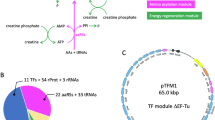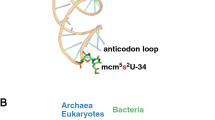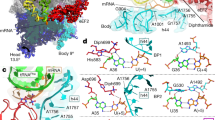Abstract
DURING the biosynthesis of selenoproteins in both prokaryotes and eukaryotes, selenocysteine is cotranslationally incorporated into the nascent polypeptide chain1, 2 through a process directed by a UGA codon that normally functions as a stop codon3–5. Recently, four genes have been identified whose products are required for selenocysteine incorporation in Escherichia coli6. One of these genes,selC, codes for a novel transfer RNA species (tRNAUCA) that accepts serine and cotranslationally inserts selenocysteine by recognizing the specific UGA codon7. The serine residue attached to this tRNA is converted to selenocysteine in a reaction dependent on functional selA and selD gene products8. By contrast, the selB gene product (SELB) is not required until after selenocysteyl-tRNA biosynthesis8. Here we present evidence indicating that SELB is a novel translation factor. The deduced amino-acid sequence of SELB exhibits extensive homology with the sequences of the translation initiation factor-2 (IF-2) and elongation factor Tu (EF-Tu). Furthermore, purified SELB protein binds guanine nucleotides in a 1:1 molar ratio and specifically complexes selenocysteyl-tRNAUCA, but does not interact with seryl-tRNAUCA. Thus, SELB could be an amino acid-specific elongation factor, replacing EF-Tu in a special translational step.
This is a preview of subscription content, access via your institution
Access options
Subscribe to this journal
Receive 51 print issues and online access
$199.00 per year
only $3.90 per issue
Buy this article
- Purchase on Springer Link
- Instant access to full article PDF
Prices may be subject to local taxes which are calculated during checkout
Similar content being viewed by others
References
Zinoni, F., Birkmann, A., Leinfelder, W. & Böck, A. Proc. natn. Acad. Sci. U.S.A. 84, 3156–3160 (1987).
Böck, A. & Stadtman, T. C. Biofactors 1, 245–250 (1988).
Zinoni, F., Birkmann, A., Stadtman, T. C. & Böck, A. Proc. natn. Acad. Sci. U.S.A. 83, 4650–4654 (1986).
Chambers, I. et al. EMBO J. 5, 1221–1227 (1986).
Sukenaga, Y., Ishida, K., Takeda, T. & Takagi, K. Nucleic Acids Res. 15, 7187 (1987).
Leinfelder, W. et al. J. Bacteriol. 170, 540–546 (1988).
Leinfelder, W., Zehelein, E., Mandrand-Berthelot, M. A. & Böck, A. Nature 331, 723–725 (1988).
Leinfelder, W., Stadtman, T. C. & Böck, A. J. biol. Chem. 264, 9720–9723 (1989).
Dever, T. E., Glynias, M. J. & Merrick, W. C. Proc. natn. Acad. Sci. U.S.A. 84, 1814–1818 (1987).
LaCour, T. M. F., Nyborg, J., Thirpu, S. & Clark, B. F. C. EMBO J. 4, 2385–2388 (1985).
Gualerzi, C. O. et al. in Structure, Function, and Genetics of Ribosomes (eds Hardesty, B. & Kramer, G.) 621–641 (Springer, New York, 1986).
Arai, K., Kawakita, M. & Kaziro, Y. J. Biochem., Tokyo 76, 293–306 (1976).
Pingoud, A., Urbanke, C., Krauss, G., Peters, F. & Maass, G. Eur. J. Biochem. 78, 403–409 (1977).
Petersen, H. U., Roll, T., Grunberg-Manago, M. & Clark, B. F. C. Biochem. biophys. Res. Commun. 91, 1068–1074 (1979).
Knowlton, R. G. & Yarus, M. J. Molec. Biol. 139, 721–732 (1980).
Maxam, A. M. & Gilbert, W. Meth. Enzym. 65, 499–561 (1980).
Jones, M. D. et al. Eur. J. Biochem. 108, 507–526 (1980).
Sacerdot, C. P., Dessen, P., Hershey, J. W. B., Plumbridge, J. A. & Grunberg-Manago, M. Proc. natn. Acad. Sci. U.S.A. 81, 7787–7791 (1984).
Kohno, K. et al. Proc. natn. Acad. Sci. U.S.A. 83, 4978–4982 (1986).
Van Noort, J. M. et al. Eur. J. Biochem. 160, 557–561 (1986).
Jonak, J., Pokorna, K., Meloun, B. & Karas, K. J. Biochem. 154, 355–362 (1986).
Van Noort, J. M., Kraal, B. & Bosch, L. Proc. natn. Acad. Sci. U.S.A. 82, 3212–3216 (1985).
Leinfelder, W., Forchhammer, K., Veprek, B., Zehelein, E. & Böck, A. Proc. natn. Acad. Sci. U.S.A. (in the press).
Author information
Authors and Affiliations
Rights and permissions
About this article
Cite this article
Forchhammer, K., Leinfelder, W. & Böck, A. Identification of a novel translation factor necessary for the incorporation of selenocysteine into protein. Nature 342, 453–456 (1989). https://doi.org/10.1038/342453a0
Received:
Accepted:
Published:
Issue Date:
DOI: https://doi.org/10.1038/342453a0
This article is cited by
-
The unique tRNASec and its role in selenocysteine biosynthesis
Amino Acids (2018)
-
Crystal structures of the human elongation factor eEFSec suggest a non-canonical mechanism for selenocysteine incorporation
Nature Communications (2016)
-
Genome‐scale engineering for systems and synthetic biology
Molecular Systems Biology (2013)
-
Effects of combinatorial expression of selA, selB and selC genes on the efficiency of selenocysteine incorporation in Escherichia coli
Chemical Research in Chinese Universities (2013)
Comments
By submitting a comment you agree to abide by our Terms and Community Guidelines. If you find something abusive or that does not comply with our terms or guidelines please flag it as inappropriate.



